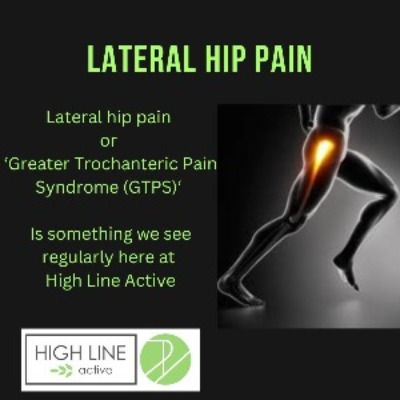Lateral Hip Pain
- Dane Monaghan - Physio
- Mar 16, 2023
- 2 min read
Updated: May 24, 2023

Lateral hip pain is a presentation that we see often here at High Line Active Physiotherapy in Richmond.
More recently, a Richmond walking group regular participant presented to Physio for this exact issue and said that they weren't the only one in their group who needs to come to see the Physiotherapists here at High Line Active for some treatment and advice.
It isn’t uncommon to be feeling pain on the outside of your hip. There are many causes for lateral hip pain but most diagnoses’ are often associated with a gradual increase in pain and tenderness in that area caused by a large increase in activity.
Lateral hip pain can sometimes be referred to as ‘Greater Trochanteric Pain Syndrome’ or GTPS
The anatomy of the gluteal muscles and the TFL (Tensor Fascia Lata) muscle that surround the lateral aspect of our hip is often the reason why this pain originates in the first place. Once the tendons of these muscles are aggravated, different hip movements can cause compressive forces on these already aggravated tendons making them give increased levels of pain. - Movements such as hip adduction (bringing your hip across your body) is just one of these movements

Populations which this is more common in
- Females are more likely than males to have GTPS due to the slightly different anatomy of their pelvis as well as hormonal differences (Lin & Fredericson, 2015)
- Most prevalent in those aged 40-60
Risk factors of getting GTSP
- Load spike / Large increases in activity (Particularly repetitive lower body tasks like running or walking) - Sedentary lifestyle
- Obesity
- Weakness of the muscles around your hip

Signs and symptoms of GTPS
- Sitting for long periods of time
- Standing on one leg
- Stretching your leg across your body
- Long Walks or stair climbing - Lying/sleeping on your side
- Shifting your weight onto the affected side
- Following or during high-intensity exercise
Long walking loads are what we saw in the Richmond walking group example when they presented to Physio

Does any of this sound familiar? If so, we want to help!
Physiotherapy has the tools to help manage your pain and aim to prevent it in the future. Techniques such as manual therapy and education will aim to relieve the symptoms in the early stages which should be followed up by an exercise program with appropriate loading for your hip. These cannot just be ‘off the shelf’ exercise programs as everyone’s hips and load tolerances are different.
So come on into High Line Active Physiotherapy here in Richmond if this is relevant to you, a loved one, a work colleague, or anyone else. We love looking after our community and can't wait to help
Lin CY, Fredericson M. Greater Trochanteric Pain Syndrome: An Update on Diagnosis and Management. Curr Phys Med Rehabil Rep. 2015;3(1);60-66.

Comments